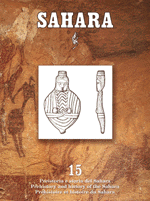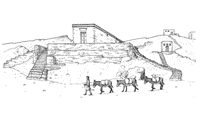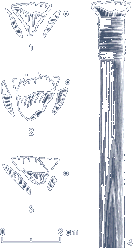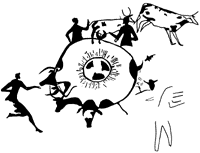 |
|||||||||||||||||||||||||||||||
Using archaeological and ethnographic data, this paper suggests that the ancestors of many modern Saharan pastoral groups, e.g. Tuareg, Toubou, Beja, may have had connections during the mid- to late-Holocene. Deep-meaning, exemplified by rock art and funerary monuments in the past, and pre-Islamic religious beliefs in the present, offer clues to a possible common heritage. It is further suggested that prehistoric Saharan herders may have been cultural innovators, and ideas spread from the Sahara to the Nile Valley and the Maghreb.
|
|
59 |
|
 |
The study of a small incised scene reminiscent of the Wa-n-Amil / Iheren-Tahilahi style, recently discovered in a site of the Akâkûs where pictograms and painted petroglyphs of the same style also appear, reveals that they all belong to the same cultural horizon. This scene depicts several sheep which could not have been introduced here before the 6th millennium bp, according to our present knowledge of the apparition of domestic ovicaprids in the Central Sahara. Thus, Saharan pictures depicting ovicaprids in this area are bound to be younger. This is true for the paintings (and now the petroglyphs) of the Wa-n-Amil / Iheren-Tahilahi style (which were already considered to have been made after the post-Neolithic Arid), but it must also be true for all the sheep listed among the great petroglyphs of the «Naturalistic Bubaline» - a fact leading us to revise the chronologies based on this so-called «period».
| 75 |
L'industrie de Foum Arguin (nord-ouest de la Mauritanie)
Une culture épipaléolithique de l'ouest saharien, entre cap Juby et cap Timiris
ABSTRACT
An occupation preceding the Neolithic has come to light in the last few years in the western Sahara. It can be called "Epipalaeolithic of Foum Arguin", from the name of a group of sites to the southeast of Nouadhibou. Its industry occurs between north-western Mauretania, where it is particularly abundant, and cap Juby, in the southern part of oued Draa, in the Moroccan Sahara. The Foum Arguin people were nomadic hunters. Their lithic tools are characterized by spectacular tanged points which, following random finds, for a long time were wrongly considered as a very recent evolution of the Aterian. The Foum Arguin culture is - indirectly at the moment - dated to the 7th millenium B.P. and precedes the Neolithic in the whole region.
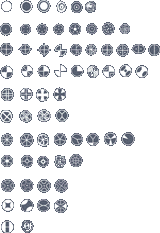
| 83 |
Le site de Tondiédo à Markoye (Burkina Faso). Élaboration d’un modèle théorique pour l’étude de l’art rupestre protohistorique du Sahel Burkinabé
ABSTRACT
Tondiedo, a rock-art site dating back to the very end of the Iron Age, was discovered in the Markoye area of Burkina Faso in west Africa. A characteristic feature of this site is the distribution of engravings on the scale of a rocky hill of limited size. The study of these engravings was undertaken in 1997, right at the start of our work in the Sahel. Gradually, the whole system of engravings, clearly of Libyco-Berber inspiration, revealed an original pattern of internal organization. The remarkable Tondiedo ensemble, unpublished to this day, is therefore an emblematic case and was selected as a model for the clearness of its rupestrian structure. The main panel, established in a suggestive place, is surrounded by an orderly variety of engravings organized in a halo shape. Image processing via computer graphics confirms the arrangements with clarity and precision. Neighbouring sites confirm, to an extent, the suggested organization pattern.
 |
| 97 |
Umm Marrahi. An early Holocene ceramic site, north of Khartoum (Sudan)
ABSTRACT
The authors describe and discuss the nature and significance of prehistoric cultural material obtained from test excavation at the site of Umm Marrahi, north of Khartoum. The material includes fauna, stone artifacts and pottery. The latter is characterized by the dominant wavy-line and dotted wavy-line types defined by Arkell in the 1950's as cultural marker of what he called "Early Khartoum Culture" or "Khartoum Mesolithic". The occupants of the site subsisted mainly on fishing and hunting savannah mammals. There is no evidence for domestic animals or cultivated plants. The combined evidence from archaeology and C14 dates shows that the settlement goes back to early 9th millennium B.P. Comparisons and evaluation of pottery types in this site and others in central Sudan suggest that Umm Marrahi was, perhaps, the earliest place of pottery production in the Nile Valley so far known.
Top
